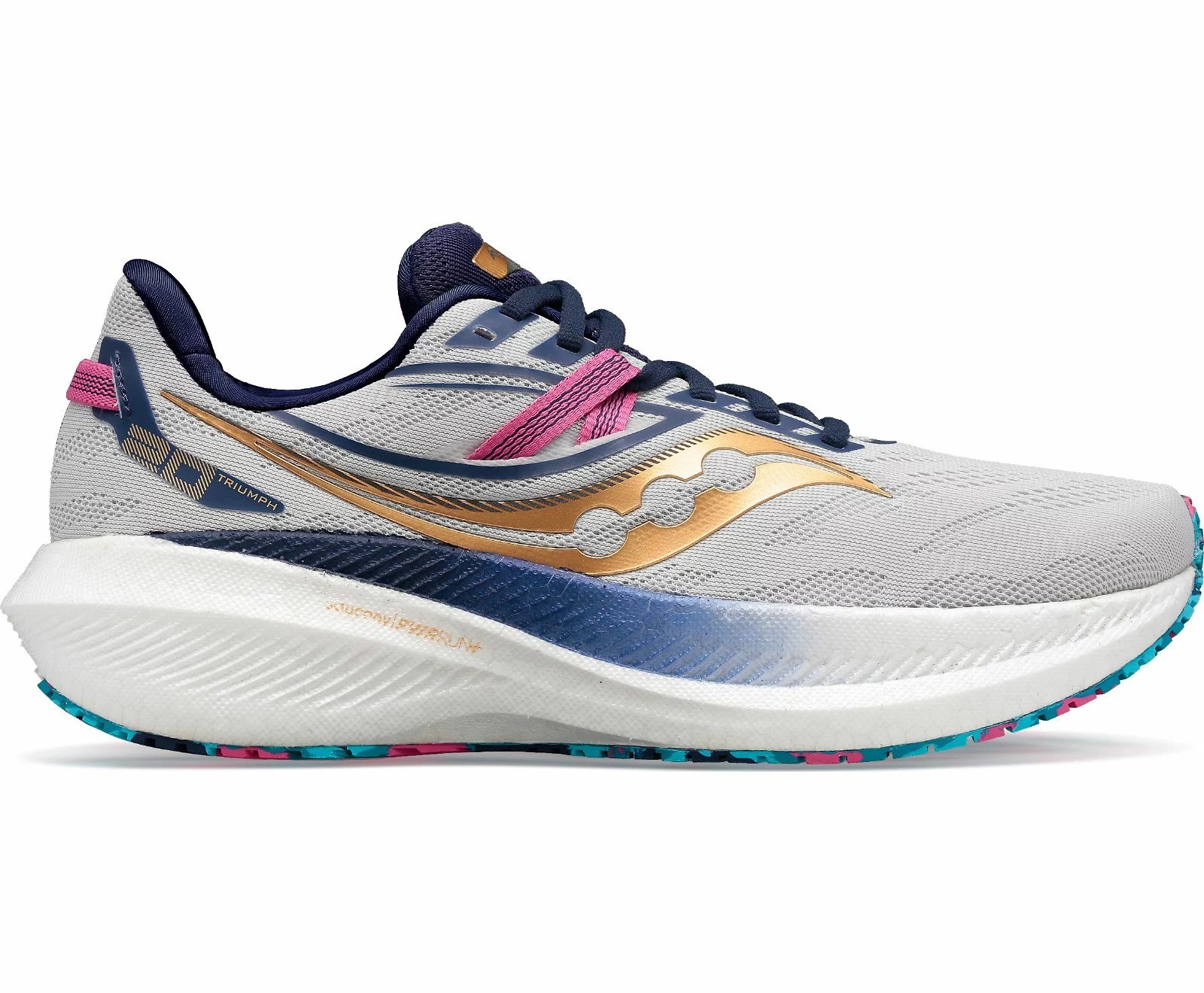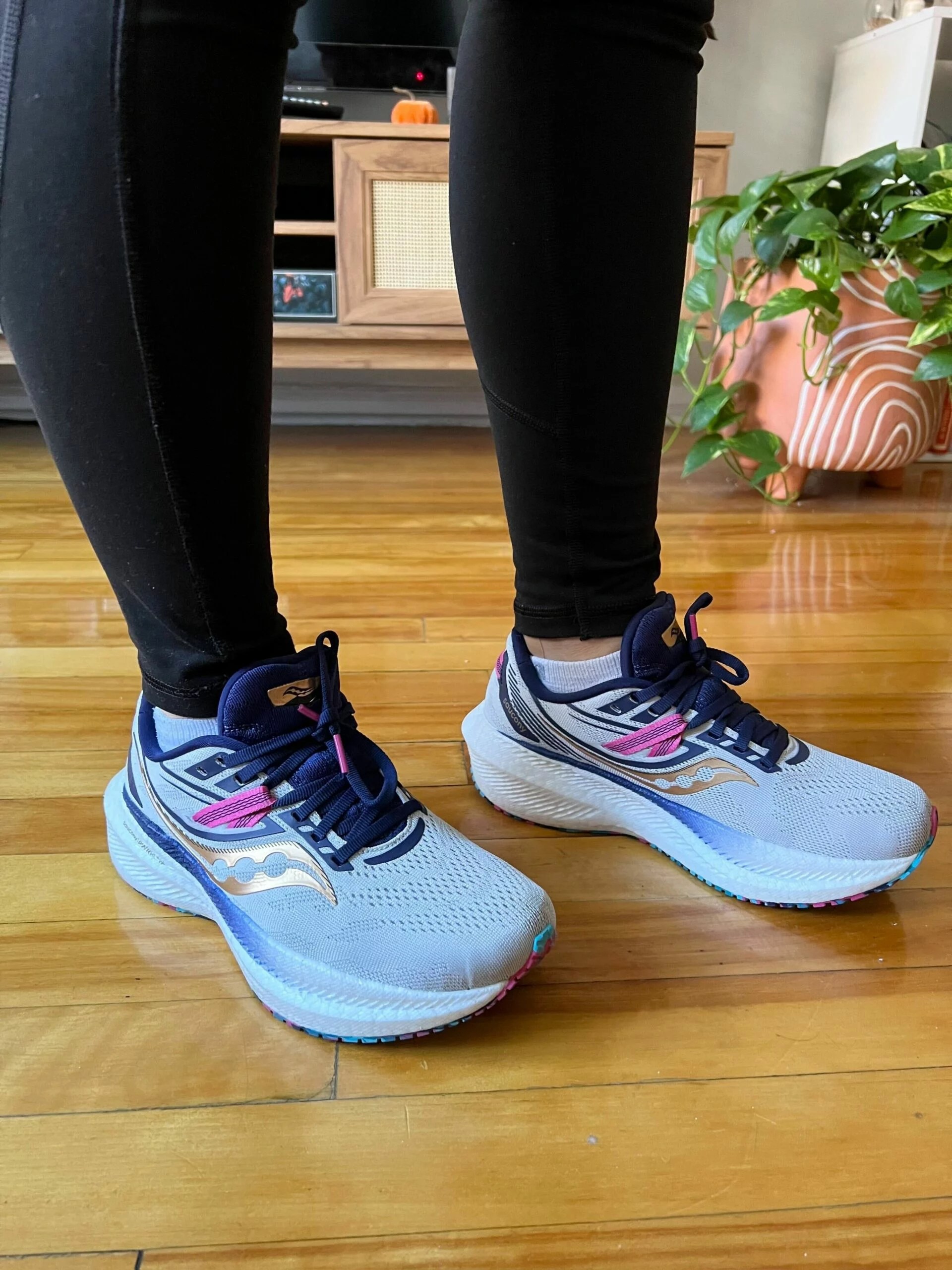

I've been running long distances since the fifth grade, but it wasn't until college when I began to incorporate weightlifting into my workout routine. As you might imagine, I've run through quite a bit of running shoes and brands over the years—I change my running shoes after 300-500 miles as recommended by podiatrists—many of which left me with shin splints, inflamed heels, and bunion irritation. So, when I was given the chance to test out the new-ish Saucony Triumph 20 everyday running and walking sneakers, I immediately pounced on the opportunity.

Sizes available: 5-12
Featuring a cushioned footbed and thick rubber sole, the Saucony Triumph 20 are ideal for long-distance runs, walks, and everyday training.
Colors: 6
Sneaker highlights
- PWRRUN+ foam cushioned footbed
- Boat-like design to propel you forward
- Lace-up system
- Durable, rubber sole
- Lightweight and breathable
My experience wearing the Triumph 20
I've tried all major running shoe brands, but I was impressed with Saucony immediately. The shoe features a foam cushion and thick rubber outsole that's both lightweight and comfortable. Since the cushioning and outsoles are so thick, it absorbs shock (so my knees and joints don't have to) during long-distance runs, sprints, and everyday training. As someone who runs and lifts weights daily, the Triumph 20s are extremely comfortable to wear and withstand all of my lifts (except squat days because leg days are reserved for flat shoes), no matter if I'm doing military presses or dumbbell flies. Even more, the outsole is shaped like a boat, making it seamless to transition from heel-to-toe during runs.
Another notable feature is the lace-up style and stretchy mesh of the shoe. With a bunion, it's irritating and painful to slip into non-adjustable shoes. With the laces, I can give more slack to my bunion area while tightening up narrower parts near my ankle. Remember, happy bunions = a happy life.
I'm not the only one who sings their praises of this shoe. Runners and fitness enthusiasts adore working out in the Triumph 20s, too. "Love running in this shoe, extremely comfortable, not too heavy, great traction, and have enjoyed on both short and long distances in my easy and tempo paces," says one Saucony shopper. "Definitely my new favorite all-rounder in my rotation."

Treadmill
Raining one day, snowing the next: New York weather is unpredictable and for that reason—coupled with the fact that there are no public running spaces in my neighborhood—you'll likely find me at my local gym's large conveyer belt, aka the treadmill. During my testing, I ran and sprinted in these shoes for about a month. The result? Fewer instances of knee and shin splint pain. Compared to other running shoes I've tried and tested in the past, this pair outperforms in the cushion department.

{{post.sponsorText}}
In terms of the shoe's rigid outsole, it gives me enough traction, so I don't slip and slide. So far, I haven't felt unstable during sprints (think: 6:50-7:50 pace) or while jumping rope.
Pavement
At times, shin splints can hamper my workout and prevent me from hitting the pavement. In this case, it would be NYC concrete, but thanks to the supportive midsole, I'm able to actually run outside. The brand's proprietary PWRRUN+ pillowy footbed absorbs all of the shock without the added pressure on my knees and joints. It also helps that the outsole is responsive, soaking up all the unwanted pressure with each strike.
Running on pavement is hard as is, but the boat-like design makes it easier to propel into my next step. The design creates better heel-to-toe momentum, or in my case, forefront running momentum, to help me reach the distances I want to run faster, be it half a mile or two miles.
If you have wide feet...
One caveat to mention is that the regular Triumph 20s have a narrower toe box, which can put pressure on my big toe during walks and runs. This pressure can be bothersome at the end of my workout, so if you have wide feet, I'd recommend choosing the wide width at check out.
Final thoughts
Working out in the Triumph 20s have been a life saver on my knees and feet. I no longer have to skip gym days or outdoor jogs due to injuries, and can take my runs to new distances and speeds. With the rigid outsole, I don't have to worry about slipping or sliding, but caution: your socks will soak when it rains, as these shoes are not water resistant or waterproof. Another thing to note is that the shoe laces are a bit short, so it can be difficult to tie (sorry, double knotters).
These kicks go for roughly $160, which is typical or close in price to some quality running shoes I have in my closet. With a marshmallow-like footbed, rigid outsole, and lace up system, I'd recommend the Triumph 20 shoes to mid- and long-distance runners, marathon runners in training, and fitness enthusiasts.
Want to be the first to hear about the latest (and greatest) SHOP product drops, custom collections, discounts, and more? Sign up to have the intel delivered straight to your inbox.
Loading More Posts...
